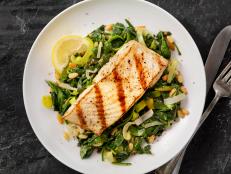This Is the Easiest Way to Grill Vegetables This Summer
Sometimes doing less work yields the best results!

Believe it or not, almost any vegetable — from giant bell peppers to jumbo eggplants — can be grilled whole. Before throwing your favorite garden variety onto your barbecue though, you'll want to pay close attention to the level of heat you’re using and the vegetable’s placement on your grill. Both play an extremely important role in helping your veggies achieve optimal flavor and texture.
When it comes to heat, you want to make sure you understand the difference between direct and indirect heat. Direct heat means you’re placing your veggies right over your heat source, while indirect heat means that half the grill is heated and the vegetables are placed next to, but not over, the heat source. Once you determine which heat source is best for your cooking needs, you can move on to the grilling method. Some vegetables work well with any of these cooking methods, while others are suited for just one. Keep reading to see which one’s best for you.
Fast and Furious Grilling
This grilling method yields maximum char flavor while the high direct heat cooks the exterior of the vegetables in a snap. Because of that, the best options are vegetables that cook through quickly, like asparagus or okra, or vegetables that are still pleasant to eat even if they get a bit crunchy. These grilled carrots spend just enough time on the grill for a lovely char to develop on all sides and a crisp-tender but not fully soft interior to form. This method should work well with any vegetable you enjoy raw. This can also work for foil packets filled with small vegetables, like fingerling potatoes, because the foil will help protect them from burning and the sealed packet will help steam the vegetables faster than if they were unwrapped.
Slow and Low(ish) Grilling
This method of grilling will work for almost any vegetable, if you have the time and don’t mind less charring. Simply place whole vegetables, such as eggplant, zucchini, cabbage and peppers on the grill over indirect heat and let them go! The heat can range anywhere from medium-low to medium-high, but it’s their placement to the side of the heat source that’s key. As they slowly cook, the water inside the vegetables turns to steam to cook from the inside out. Though the outsides of your chosen vegetable will get lightly brown, it will lack the same intensity as when it's charred right over the fire. The upside of this method is that it can turn watery vegetables — which can be tricky to get right, like eggplant — into a vegetable with a fully-cooked and tender custard-like interior. If you’ve ever had sliced grilled eggplant, you can already see the appeal here.
It can also give a meltingly soft bite to whole cabbage or bell peppers, though removing the tough bottom core from the cabbage is important to allow the center of the cabbage to get some heat. Because vegetables cooked in this way can spend more than an hour on the grill, they absorb a gentle smokey flavor while they cook which acts as a delicious compliment to a splash of vinegar, fresh herbs or a dollop of your favorite condiment.
The Middle Ground
This method is best for sturdy vegetables that need to be fully cooked and can withstand more time over direct heat, like whole potatoes or small eggplant. In both cases the skins of the vegetables can withstand the heat without tearing, and take some time before they start to char. Adding heavy duty foil on the potatoes will add protection to their skins. Eggplant will cook a bit faster over medium-high heat. The skins will eventually become tender and well-marked.
If cooking vegetables with this method, make sure to keep an eye on them and turn them occasionally, or move them around the grill to ensure that they cook through evenly, and don’t spend too much time over a hot spot or an extra cool zone.
The Finish
Once you have your lovely cooked whole vegetables, don’t forget to give them a little finishing love. Because they weren’t sliced up before cooking, there won’t be much seasoning on the insides. Treat their lovely natural flavor like a blank canvas and go with your mood. A drizzle of oil and sprinkle of crunchy salt can be enough or you can go bold with chopped Calabrian chiles, fresh garlic and tons of herbs. The vega-bilities are endless!
Related Links:
































